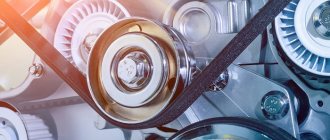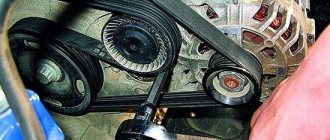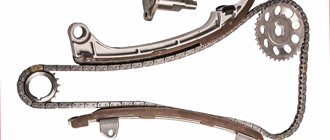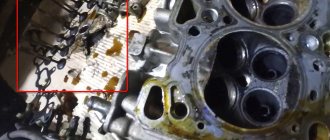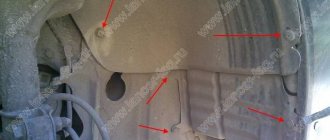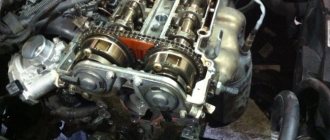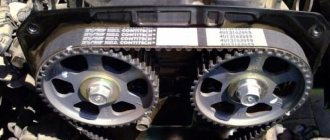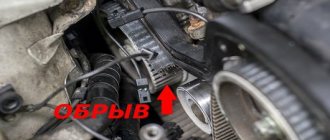Author: Sochi Auto Repair
During the operation of a car, situations inevitably arise that alarm the driver. One of these problems is the annoying whistle of a running engine. Why does the engine whistle? The problem is not the most serious, but it prevents the driver from concentrating on the road and distracts him from the process of driving.
Drivers often turn to specialists at service stations with the same complaint - a low, annoying whistle that occurs when the gas pedal is pressed, persists while driving, and then slowly stops after the gas pedal is released, and this cycle is repeated every time the pedal is pressed. . Usually only the driver of the car reacts to this whistle.
Why does the engine whistle?
If a car enthusiast understands at least a little about the material part of his car and feels it, he can fix this problem on his own.
The main signs of a whistling engine sound:
- the whistle starts when the gas pedal is pressed;
- the whistle is very quiet and can be heard in the absence of other sounds in the cabin;
- after releasing the gas pedal, the whistle subsides;
- Usually this sound remains unnoticeable for a long time and “appears” somehow completely suddenly;
- such a whistle is not heard outside the car, and passengers do not notice it at all, since they do not feel the connection between the occurrence of the sound and the pressing of the gas pedal;
- In timbre, this sound resembles a “human” whistle and differs significantly from “squealing”, “howling”, “creaking” and “grinding”.
Why does the engine whistle? First, you need to exclude possible sources of the problem with a similar sound. First of all, problems with the brake pads are eliminated, because their “squealing” occurs when you press the brake pedal (or gas pedal + brake pedal).
All problems with belts located under the hood next to the engine are also eliminated.
Belts are the main source of whistling sounds under the hood, but their tone and intensity are completely different. The belts begin to whistle while the engine is warming up. Their problem is slipping relative to the driving and driven rollers.
The moment you press the gas, the belt comes into unison with the rollers, normal operation begins and the whistling stops. It is simply impossible not to notice the whistle emitted by the belt - it is very loud and annoying. The issue of quiet and monotonous sound is also discussed here.
The third possible source of sound why the engine whistles is rollers and bearings. During operation, these parts wear out a lot and begin to “sound,” but they produce sounds of a different type - low, howling. The rollers and bearings begin to “howl” even at idle speed; after pressing the gas, the sound intensifies, but then subsides.
For an experienced technician, the difference between a “howl” and a “whistle” is obvious, especially if a professional is repairing the machine.
After analyzing all the symptoms and options, eventually a good auto mechanic will realize that the source of the problem is the engine intake system.
Eliminating the causes of a whistling engine sound
If a whistling sound is localized at the intake, it is necessary, firstly, to carry out maintenance on the throttle valve - it must be cleaned.
Constant use of the throttle valve leads to severe contamination of the moving parts and, as a result, to “jamming” in certain positions. Because of this, the air, passing under pressure through the damper, begins to whistle. Sometimes, to eliminate the sound, it is enough to simply rinse the damper thoroughly. However, we must remember that in order to properly clean the throttle assembly, it must be removed and completely disassembled.
This is a useful preventive procedure, but it does not always eliminate the whistling.
Therefore, it is necessary to focus on the next device in the intake system - the PCV valve. It is responsible for recirculating crankcase gases. When the engine is running, the air pressure in the crankcase increases due to the movement of the cylinder pistons and heating of the air. Hot air requires additional outlet, otherwise the high pressure will squeeze the oil through the oil seals and any seals. It is impossible to replace the valve with a regular ventilation hole - this may lead to incorrect formation of the air mixture at the inlet.
To understand why the engine whistles and where the whistle comes from, it is necessary to consider the valve design. The valve body has a piston pressed by a spring on the air outlet side. If the engine is turned off, the valve is closed. When the required crankcase gas pressure is reached on the valve, the spring moves, allowing gases to enter the intake system.
Chemistry against noise
In those distant times, when auto chemicals were almost a fantasy, they also struggled with whistling.
And with the most ingenious methods. Despite the fact that the belt cost a penny, they tried to save it by any means necessary. The most popular, which you can, by the way, take note of, was the method of impregnating the belt with rosin. Regular rosin for soldering. It was dissolved in alcohol and the belt was treated with this solution. For some time, the belt became silent, since the rosin helped to increase the coefficient of resistance to slipping, the belt became more elastic, did not crack and tear so quickly, and in general, it lasted longer. The Hi-Gear Belt Dressing aerosol offers something similar.
The price of such joy is about 350 rubles, but it will not fundamentally solve the issue. The purpose of the spray is to give the belt elasticity and an aesthetically pleasing appearance (which the spray does better). Ideally, the new belt is treated with the solution before installation, but the instructions say that the life of the old belt will last twice as long with periodic use. The spray can be used for both V-shaped and serpentine belts. Chemical means can actually improve elasticity; the belt will not crack and dry out. This is not a panacea, but the beauty of the tool is that with its help you can find out exactly what is whistling - the belt or the bearing.
My Sonata Club Hyundai Sonata
Whistle when turning the steering wheel to the left
The heart of the Sonata is the engine, engine compartment sensors, engine control system (ECU)
Alexey010Newbie Messages: 7 Registered: Jan 27, 2012, 4:41 pm Reputation: 0 Auto: Real name: Alexey From: Tula
Message by Alexey010 » January 27, 2012, 16:55 » Message # 186853
Sonata 2.0 automatic transmission 2005, when the engine starts, a whistle appears and continues for about 5-6 seconds, then it hits. The belts and rollers have been changed.
Message by Shind » Jan 27, 2012, 04:58 pm » Message # 186856
Tighten your belts.
There was a Sonya AT-4.2006-2011. Remained in the club in good hands (for the third time). Mitsubishi XL 3.0/ 220 thousand hamsters + several thousand after miracles/Silver 2011-2017 (sold) Volkswagen Touareg 3.6 FSI 249 hp blacker than the night, pneuma and everything to the maximum.
ShindAksakalMessages: 5487Registered: March 28, 2010, 21:51Reputation: 43Car:Real name: AlexeyFrom: Moscow
Post by Shind » Jan 27, 2012, 5:13 pm » Message # 186865
Are you sure? That’s what many said, argued with all the comrades and as a result pulled it up and everything was lost.
There was a Sonya AT-4.2006-2011. Remained in the club in good hands (for the third time). Mitsubishi XL 3.0/ 220 thousand hamsters + several thousand after miracles/Silver 2011-2017 (sold) Volkswagen Touareg 3.6 FSI 249 hp blacker than the night, pneuma and everything to the maximum.
TYRISTYI live hereMessages: 1865Registered: 04 Jan 2012, 15:25Reputation: 1Car:Real name: PavelFrom: Ukhta, Komi region
Post by TYRIST » Jan 27, 2012, 05:19 pm » Post # 186866
2.0, leather, Sirius, mechanics, climate, R-16 winter, R-17 summer.
Message by Bogind » January 27, 2012, 20:48 » Message # 186951
depending on where the whistle is coming from and the muffler may be the pump and the bearing may be losing and making a whistle lia-maks Joined Messages: 220 Registered: 09 Jan 2012, 22:26 Reputation: 0 Car: Real name: Ildar From: Kazan
Post by lia-maks » Jan 28, 2012, 05:21 pm » Post # 187315
I have the same problem with the same engine, everything is tight, the whistle does not disappear, I blame the power steering pump bearing!
I'm selling complete cast wheels!
Alexey010Newbie Messages: 7 Registered: Jan 27, 2012, 4:41 pm Reputation: 0 Auto: Real name: Alexey From: Tula
Message by Alexey010 » 18 Feb 2012, 09:46 » Message # 194982
The belts were tightened by the officials, the whistle disappeared, but after a week it starts again, but not the same as it was, a little quieter and rustier
clon76 Slowly getting in Messages: 85 Registered: 09 Oct 2010, 01:41 Reputation: 0 Car: Real name: Vladimir From: Elektrostal
Message by clon76 » 18 Feb 2012, 19:54 » Message # 195132
And the high pressure hose isn't leaking? Or as an option...
matvei55 Newbie Messages: 4 Registered: November 16, 2011, 21:00 Reputation: 0 Car: Real name: Nikolay From: matvei55
Message by matvei55 » 22 Feb 2012, 12:40 » Message # 196483
I have the same problem. It squeaks, and in the cold. How are the alternator and timing belts tightened? And what does it mean [And the high pressure hose does not snot?[
Last edited by matvei55 on Feb 27, 2012 10:59 pm, edited 1 time in total.
Message Vladimir 102 » 22 Feb 2012, 13:08 » Message # 196493
I have a whistle when I turn off the engine, the belts are all tightened, no one who asked anyone will understand what the reason is, and I’ve been driving like this for a year now
Sonata.Silver.2l.Beta. Manual transmission, 2MT. Kayaba all around, Killen rear springs -1.25 turns. Sold.
sergus151Newbie Messages: 2 Registered: March 15, 2012, 03:56 pm Reputation: 0 Car: Real name: Sergey From: Moscow
Message by sergus151 » March 31, 2012, 13:57 » Message # 208624
Hello) there is a problem like this, it whistles, I don’t know what to call it, to the left of the engine, one turns on the air conditioner and the other seems to be a generator. Tell me what is the name? Sonata 2004 2.0 liter
Go
Belt whine when turning on the air conditioner
Why does the alternator belt whistle when starting the engine or air conditioner?
This whistle is more unpleasant because the alternator belt may have nothing to do with it. Although, given the changing load on the generator, it is quite possible that the belt slips along the pulley under load. The probability is small, but it is there. In this case, you just need to tighten the belt and the whistling should stop. If the whistle remains, the problem is in the air conditioning compressor, and the whistle is most likely the air conditioning compressor clutch drive belt.
It may not always be the alternator belt that whistles when the air conditioner is turned on.
There is very little pleasant here, since the minimum that you have to do to eliminate the noise is to change the oil in the compressor (depending on the design of the air conditioner - Kia Sid, Kia Rio, Hyundai Accent, Tuscon). In some cases, the compressor drive clutch may slip - due to the lack of the required amount of freon, the compressor lacks lubrication and, naturally, it is more difficult for it to spin. This also affects the load on the electromagnetic clutch. You can also try lubricating all the compressor bearings and the bearings on the pulley, again depending on the design of the air conditioner. If all else fails, replace the compressor or electromagnetic clutch.
Other possible causes of whistling under the hood: power steering, air conditioning, water pump
Similar to the main reasons for whistling generator belts, similar noises can occur in other units that are driven by a belt drive. The air conditioning compressor, or rather the clutch drive belt, may whistle. This can be easily checked by turning the air conditioning system on and off. In rare cases, the generator belt may whistle after turning on the climate control, which occurs as a result of a significant increase in the load on the generator.
You should also not exclude:
- possible slippage of the compressor drive clutch, which becomes more difficult to spin due to an insufficient amount of refrigerant (frion) in the system. The fact is that freon is a lubricant for the compressor;
- It is additionally necessary to check the performance and quality of lubrication of the compressor bearings and pulley, which will depend on the features of a particular design. Similar recommendations can also be applied to the power steering pump and its drive, as well as to the liquid pump of the engine cooling system;
During operation, it is recommended to treat drive belts with special chemical compounds that preserve elasticity and protect the rubber product from cracking and drying out. The use of special equipment allows you to reduce noise during operation and extend the service life of the belt. Such products can be used for V-shaped or serpentine-type drive belts.
After replacing the alternator belt, especially with affordable non-original solutions, a whistle after starting the engine may occur due to the poor quality of the installed product. The possibility of insufficient tension should also not be ruled out.
An additional operation is the need to lubricate the tension roller, if provided for by the design. You should also pay attention to ensuring that the correct alignment of the pulleys along the axes is maintained. Another reason for the whistling noise may be too much tension in the drive belt. Over-tightening leads to increased load on the generator bearing and tension roller.
Finally, we add that to accurately determine the source of the whistle, it is recommended to treat the drive belt with a special agent. If the whistling becomes less intense or disappears, then the problem lies with the belt and not with the condition of the pulley itself or the attachment bearings.
General recommendations for finding the causes of noise
Engine control unit G15MF IEFI-S
There can be a lot of reasons for the whistling noise, some of them are to blame for the belt itself, some are due to other components and parts, and as you can see, the list of faults is impressive. Summarizing all that has been said, let us give some general recommendations that will save your ears and, possibly, the engine from damage.
As soon as the whistle makes itself felt, first of all you need to:
check the condition of the belt - if the belt is new, installed a week ago, and the whistle constantly appears after replacement, it is not a fact that the belt is of high quality, even a brand new one can whistle; The degree of belt tension must be checked - 90% of all problems with whistling are removed after adjusting the tension or lubricating the tension roller; It is worth paying attention to the alignment of the pulleys, to a greater extent this applies to VAZ 2110, 2109, VAZ 2112, as well as cars where the generator has a stamped belt tension bracket - Daewoo Nexia, Lanos, Matiz; Cleanliness of the surface of the belt and pulleys is an indispensable condition for the normal operation of the belt drive, and drops of antifreeze and oil can cause the belt to slip.
You shouldn’t get too carried away with tensioning the belt either, since when the belt is tightened, there is an increased load on the generator bearing and the tensioner intermediate roller. Each engine has its own tension standards, but on VAZ, in particular on Lada Priora, Klin, Grant, belt tension is measured not by newtonometers, but by sound vibrations.
After replacing the alternator belt, the whistle may not disappear anywhere, because the belt may be of poor quality
For this, a special device is used that analyzes belt vibrations in a certain area from the generator to the tension roller. The oscillation frequency is displayed on the device display. For VAZ Kalina models the norm is from 190 to 240 Hz, on Priora the frequency should be 120-160 Hz. In this way, you can calculate the cause and overcome the unpleasant whistle under the hood of your car.
The fastest cars in the world for the 2021 model year
Fast cars are an example of how automakers are constantly improving the systems of their cars and periodically conducting developments to create the perfect and fastest vehicle on the road. Many technologies are being developed to create a super fast car.
Luxury cars of stars
Celebrity cars must match their star status. It is simply impossible for them to arrive in something modest and publicly available. Their vehicle must match their popularity. The more popular the person, the more sophisticated the car should be. Stars popular in the world.
Rating of the most expensive cars
Throughout the history of the automotive industry, designers have always liked to single out a few unique in terms of characteristics and capabilities from the general mass of production models. At the present time, this approach to car design has been preserved. And to this day many of the world.
Rating 2021: DVRs with radar detector
The requirements for additional equipment in the car interior are growing at a rapid pace. To the point that there is simply not enough space in the cabin to accommodate all the necessary equipment. Previously, only video recorders and fragrances interfered with the view.
HOW to exchange your car for a new one, how to exchange a car.
Tip 1: How to exchange your car for a new one The dream of many car enthusiasts is to arrive at the dealership with an old car and leave with a new one! Dreams come true. The service of exchanging an old car for a new one is gaining more and more momentum.
https://avtomotospec.ru
Alternator belt whistles in the rain
Fog, high humidity, rain are ideal conditions for the V-belt drive to whistle. For obvious reasons, moisture gets on the surface of the belt and reduces the frictional ability of the material, as well as on the pulleys. Wet whistles are short-lived, but you shouldn’t relax. This means that the belt has already begun to lose elasticity and should be tightened if wear allows.
In wet weather, the frictional abilities of the alternator belt material are reduced
In any case, belt slipping indicates a malfunction in the belt drive, and rain or splashes are simply an indicator that the belt may need to be replaced soon. To avoid such problems, let the small, cunning Americans from the Hi-Gear company come up with a remedy that can temporarily save you from whistling. Let's say a few words about him.
Is repair possible?
It will only have to be repaired at a service station. Even with experience, it is difficult to understand modern gearbox and clutch systems. Therefore, it is better not to waste time, but to entrust such work to specialists. Most often it is not necessary to repair, but to change the clutch. However, for foreign cars such a solution can cost a lot of money. For example, a whistle when driving a Chevrolet Cruze car could be eliminated by replacing the entire clutch system. This is what they write on some auto forums. However, this does not mean at all that this problem is common in these machines.
Why does the engine whistle when starting?
Many motorists have encountered the fact that when they go out in the morning and start the car, a whistle is detected. But not everyone knows what causes this effect. And even more so, how to eliminate it yourself.
Determining the causes of the malfunction
The whistling sound of the engine when starting is familiar to many car enthusiasts. So, most VAZ owners can remember this sound when starting the engine in winter and not only. This meant the water pump belt needed to be tightened or replaced. With the development of the automotive industry, everything has changed. The number of such belts in vehicles has increased.
It is worth determining why a whistle is heard when starting the engine. The main reason is the failure or stretching of one of the engine drive belts. To determine the malfunction, you need to test each belt for tension.
So, let's determine and consider the reasons why the engine whistles when starting. This means that one of the following elements has failed:
- Timing belt.
- Generator belt.
- Power steering belt.
- Water pump belt.
- Other attachment drive belts.
Elimination methods
A squealing belt is perhaps the only reason why a whistle may occur when starting the engine. This means that the drive element has stretched and is slipping along the pulley.
So, this significantly increases the wear of the belt itself, which will inevitably lead to tragedy in the power unit, unless, of course, the situation is corrected in time. Let's consider repair and diagnostic operations to eliminate whistling in the engine.
Timing drive
A whistling sound in the engine caused by a faulty timing belt is more than an urgent repair. If the part is not replaced in time, this will lead to a break in the drive, and at the same time to bent valves, which inevitably leads to costs.
The average, even the best belt should be changed no later than 70,000 km. Typically, car manufacturers indicate the maintenance interval for the timing belt unit in technical documentation and service books. In any case, the motorist must monitor the condition of the components and parts of the engine of his vehicle.
With low tension, the part will slide, thereby causing a whistle. But, in modern vehicles, timing belts are used, which whistle when worn heavily.
Attachment Drive Belts
In this case the situation is still the same. Belt slippage causes a whistling sound when starting. In this case, the whistle may disappear after some time of operation. But you shouldn’t get your hopes up, because the spare part needs to be replaced as soon as possible.
Another cause of whistling, in rare cases, may be a malfunction of the water pump or drive pulleys. So, the pump has a bearing installed, which wears out over time. So, a coolant leak may form from under this element, which is quite difficult to notice, especially if it is dripping.
Thus, the production of an element can rotate it, after which the metal rubs against another metal, which leads to the formation of sound. As you know, after heating the elements expand, so the bearing, when it heated up during operation, expanded and stopped turning in the mounting location.
You can diagnose and replace damaged elements yourself if you know the design features of the car, or contact a car service center or professional locksmiths for help.
Conclusion
The reason for the engine whistling when starting is a malfunction of the accessory drive belt. Less commonly, a whistle can be caused by wear on the elements of the gas distribution mechanism and others. To eliminate the malfunction, it is necessary to diagnose and replace the failed belt in order to prevent more negative consequences for the power unit.
Debugg
Once the root causes have been identified, the troubleshooting process can begin directly. We stock up on time and tools. Now that everything is collected, we can begin. It is worth being prepared for the fact that parts will be required.
It is worth noting that for each specific make and model of car, the design features of the repair and location of parts will be different.
Drive belts
Typically, a whistling sound in the engine, especially during a cold start, is associated with belt drives. Thus, a stretched belt slips along the pulley, which creates a characteristic squeak. Often, this effect is characteristic of the timing belt on newer cars. There are two ways to troubleshoot the problem.
The first way is to tighten the belt (only for cars with a belt and a tension pulley). To do this, you will have to dismantle the protective casing that covers the timing belt, and then tighten the drive using a tension roller. Sometimes it happens that the belt is in a very worn condition and requires replacement.
The second way is to replace the belt. Replacing the timing belt is a rather complex and time-consuming task. Therefore, it is recommended to carry out this operation at a professional car service center. Many motorists, unknowingly, when replacing the drive belt, knocked out the valve timing, which subsequently brought with it serious consequences for the power unit, such as major repairs.
For different car manufacturers, the timing of replacing the timing belt will be different, but the average indicator is that the element must be replaced after 40-50 thousand kilometers.
The process of replacing the timing belt is quite simple, but at the same time difficult to complete without knowledge of the design of the vehicle, as well as repair methods. So, let's consider the main provisions for replacing the timing belt:
- To begin with, VTM labels are set. This is necessary in order not to disrupt the valve timing when replacing the belt.
- The camshaft or shafts are fixed on pulleys to prevent rotation. There is a special tool for carrying out this operation, but as practice shows, motorists carry out fixation using improvised methods.
- Next, loosen the belt by unscrewing the tension roller.
- If necessary, on some car models, the crankshaft pulley is removed.
- Remove the belt from the seats.
- Typically, assembly of the unit is carried out in the reverse order. For many American cars, there is a specific sequence for installing the timing belt. Therefore, it is recommended to study the manuals before replacing.
Rollers
Together with the timing belt, the whistling noise may be caused by a worn tension roller. This is because the belt slides over the part, creating a whistling sound. The car rollers are replaced along with the timing belt.
On some cars, the rollers can be replaced without removing the drive belt. It is worth remembering that when changing an element, it is necessary to adjust the tension of the drive belt, because if this is not done, then very soon the whistle will appear again, and the belt will be subject to increased wear.
water pump
Many Lada owners are familiar with the whistling sound that appears after starting the engine when cold and disappears after warming up. This effect was caused by faulty pump parts. In both older and newer car models, the whistling effect can be caused by the water pump.
As with the timing belt, a squealing noise can be caused by a worn water pump belt. On older domestically produced cars, the pump is driven from the crankshaft pulley, while the gas distribution chain operates on a circuit installed directly in the block. For newer cars, the pump is part of the timing belt drive.
Let's consider this variant of the occurrence of a malfunction only for the old generation of vehicles. To eliminate the problem, you will have to determine where exactly it comes from. To begin with, you can change and tighten the drive belt. Tension adjustment is usually carried out using a generator.
Before dismantling the pump and understanding the internal elements, you should pay attention to the condition of the drive pulley. During operation, this part could become deformed and cause a lot of problems. Therefore, first we examine it for deformations and position.
If the whistle does not disappear after changing the belt, then we go even deeper. In this case, it means that the whistle comes from inside the structure. What could make such a sound? Depending on the design features of the car model, a worn bearing or water pump drive shaft may whistle.
For most car models, this means replacing the water pump. But for older GAZ models, such as the Volga 24 and 3102, as well as the 53rd Lawn, in order to save money, you can directly replace the bearing and shaft itself. But not all even the most experienced car enthusiasts can perform this type of operation, so it is recommended to contact a car service center.
Generator
Another automotive element that can cause a whistling noise under the hood of a vehicle is the generator. So, as in the case of a water pump, it is worth examining the belt and drive pulley. Unlike the pump, the generator has a weak shaft that can be slightly deformed, which will disrupt the position of the pulley.
In turn, the belt will not only slip, but will quickly wear out. Therefore, before climbing directly inside, it is worth examining whether there is any external damage to the product.
In the generator itself, the whistle may be caused by worn bearings. So, they can slip on the seat or the drive shaft slides along the inside of the bearing, which causes friction between the metals, which is heard as a whistle.
To eliminate the malfunction, it is necessary to remove the generator from the vehicle. Disassembly of the part should be carried out strictly in accordance with the service manuals for diagnostics and repair. Next, when the product is disassembled, it is worth examining the condition of the shaft, bearings and seats. If faults or damage are found, such parts should be replaced. You shouldn't change anything unnecessary.
If the car owner has not repaired such products or the sequence of actions seems complicated, you should contact an auto electrician. Specialists will be able to inexpensively replace a bearing or repair generator parts. For example, replacing the shaft with a supported one that is in good working order.
Which ear?
“Tell me, dear child, in which ear I have a buzzing...” The monumental phrase of Faina Ranevskaya is more relevant than anywhere else in this case. Because whistling can, indeed, be heard in “both ears.” It may not be the alternator drive belt at all, there may be many reasons, but first you should understand the nature of the whistle under the hood, only after that you can draw some conclusions.
The cause of any whistle in V-belt drives of cars can only be friction
It doesn’t matter what interacts with what, if a whistle occurs, it means that one of the surfaces, or maybe both at once, has lost its original properties and physical characteristics. The characteristics of belts, bearings, and pulleys are influenced by a lot of external factors:
- air humidity;
- working temperature;
- natural wear and tear;
- mechanical damage;
- presence of lubricant in bearings;
- technical condition and adjustment of V-belt or toothed belt drive.
The photo shows a generator belt, which can be adversely affected by lubrication in bearings, air humidity, and operating temperature
These are just some of the things that can cause whistles and squeaks under the hood, but if you take into account the conditions in which annoying sounds appear, the problem is much easier to fix. We will start from the simplest.
What's the result?
You cannot leave a whistling sound in the engine and hope that it will go away on its own. Most likely, if you leave everything as is, then a malfunction of any system could lead to more serious problems with the engine in the future. Eliminating the whistle at an early stage will avoid high costs for engine repairs. So be sure to listen to the engine. If you find any strange whistling, try to determine more precisely where it is coming from. And if you can’t do this, then go to a service station. Let the professionals deal with this.
However, some car owners are not bothered by various extraneous noises from engines at all. They successfully drive cars that not only emit an unpleasant whistle, but also jerk when driving, accelerate and brake poorly. What can we say about some kind of whistle, which few people will pay attention to! But the vehicle is still worth checking.
Many faults in a car can be determined by sound. When some extraneous noise appears in the form of a grinding, howling or whistling noise, this may indicate a breakdown of one of the car components. Some malfunctions are quite easily eliminated along with accompanying symptoms in the form of annoying and disgusting sounds. But there are certain signs of breakdowns that appear most often. Most often, a whistle is heard when starting the engine, which can be caused by a number of factors. Moreover, similar unpleasant sounds can occur even when the engine is already running. Next, we will talk about the causes of such phenomena and ways to eliminate them.
We determine the malfunction by sound
Every hum, whistle or hiss coming from under the hood has its own overtones. At the same time, each material and each operating material has a spectrum of sound waves that are easy to identify. For example, the knock of metal on plastic can never be confused with the grinding of tin on tin. These simple sounds are not described in any textbook and are not stored in any database. But they are easily identified with experience.
A leaking exhaust manifold gasket sounds much different than a blown main exhaust line gasket. The hissing, which is caused by a loose fit of the air filter housing to the carburetor in the VAZ 2107, has completely different overtones than the hissing of the intake manifold gasket. Still, the champions in terms of piercing sounds that pester drivers are the drive belts of the generator, power steering, air conditioning and the bearings of these devices. Why the alternator belt whistles, and whether it is actually a belt, we will figure it out together.
Video tutorial on how to get rid of alternator belt whistling during a cold start
A whistling sound is heard when starting the engine
A whistling sound at start-up usually comes from the alternator belt or the cooling system water pump (pump). The malfunction manifests itself in the form of a high-frequency squeak or squeal after starting the internal combustion engine, and can also make itself felt already on a warm engine when you sharply press the gas pedal and increase the crankshaft speed.
If there is a problem with the belt, you need to check its condition and tension. Sometimes it temporarily helps to apply special rubber care compounds, which allow the surface of the belt to remain soft and elastic, protect against cracking, etc. If the tension is clearly weakened, the generator belt must be tightened, while simultaneously checking the condition of the pulleys and tensioner. Let us add that it is not recommended to tighten a strongly stretched belt, since the whistle will appear again after a short period of time. In this case, and also when it is not possible to further tighten the alternator belt, only replacement is indicated. If the belt is tensioned normally, does not slip on the pulleys, but still whistles, then it may be of poor quality and requires replacement.
Let us also add that the cause of the whistle can be not only the belt, but also the generator itself. More precisely, problems may arise with the bearings of its drive. This is indicated by a characteristic rustling, whistling, and slight crackling sound when the engine is running at idle.
The pump also makes a thin whistle at idle speed, and the problem may be accompanied by a rumbling or crackling sound. This symptom is a reason for mandatory inspection and replacement of this element.
To check the generator and/or pump, you can take a block of wood, you can also attach a tin can to the end of a wooden stick, etc. Then one end of the bar or stick is applied to the drive area of the generator or pump with the engine running, and the other end of the bar or a tin can attached to the stick is brought to the ear. This solution allows you to more accurately determine the source of noise and localize the fault. By the way, if possible, instead of a homemade device for listening to noise, you can use the so-called car stethoscope (sometimes a medical one is also used).
If the source of the noise is not fully identified, then it is necessary to remove the generator belt, after which the pump or generator pulley is sharply turned by hand. The appearance of noise, difficulty during rotation, beating, play and other deviations from the norm will indicate a problem. In the case of a generator, the device can be repaired by replacing the bearings. It is recommended to change the pump immediately, since on many cars a jammed water pump leads to a broken timing belt.
An additional reason to replace the pump is considered to be the appearance of antifreeze or antifreeze drips at the place of its installation. Coolant leaks pose a danger in the form of overheating of the internal combustion engine; a broken timing belt means that the piston hits the valves, causing the valves to bend. Ultimately, if these problems are ignored, the engine may require expensive or even major repairs.
Causes and culprits of whistling in the engine compartment
Surely every driver has noticed a characteristic whistle appearing in the engine compartment. Indeed, this is an unpleasant moment, both for the driver himself and for the people around him.
The most important thing is to understand that the whistle, depending on the places where it appears, will differ significantly and, accordingly, by the nature of the whistle, an experienced driver or a mechanic at a service station can immediately determine the unit from which the unpleasant sounds originate.
What could be whistling under the hood?
As described above, the whistle can come from different mechanisms due to some reason
And it is important to remember that when a whistle appears, this does not always mean some serious malfunction. So what can be the source of whistles of various types?
Listed above are the main elements of the car's engine compartment, where the whistling may occur.
But again, it is important to understand and distinguish the type of whistle. If the reason is a weakened alternator belt, then you need to know how the whistle manifests itself when rubber rubs against metal
If the whistle is similar to the sound of metal rubbing against metal, then these are bearings and rollers.
Conclusion
The causes of whistling in the engine are considered. This effect is usually caused by worn parts. To eliminate the problem, you need to replace one of the elements: belt, tensioner, pump or generator parts. Not all car enthusiasts are able to do the process themselves, so it is recommended to contact a car service center.
Drivers are always nervous about various external noises and sounds that may arise in the vehicle. Sometimes a whistle when the car is moving does not promise anything serious. But sometimes it can indicate some serious damage to the engine. Let's look at what are the causes of whistling and how scary it is in general.

